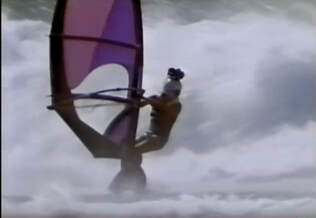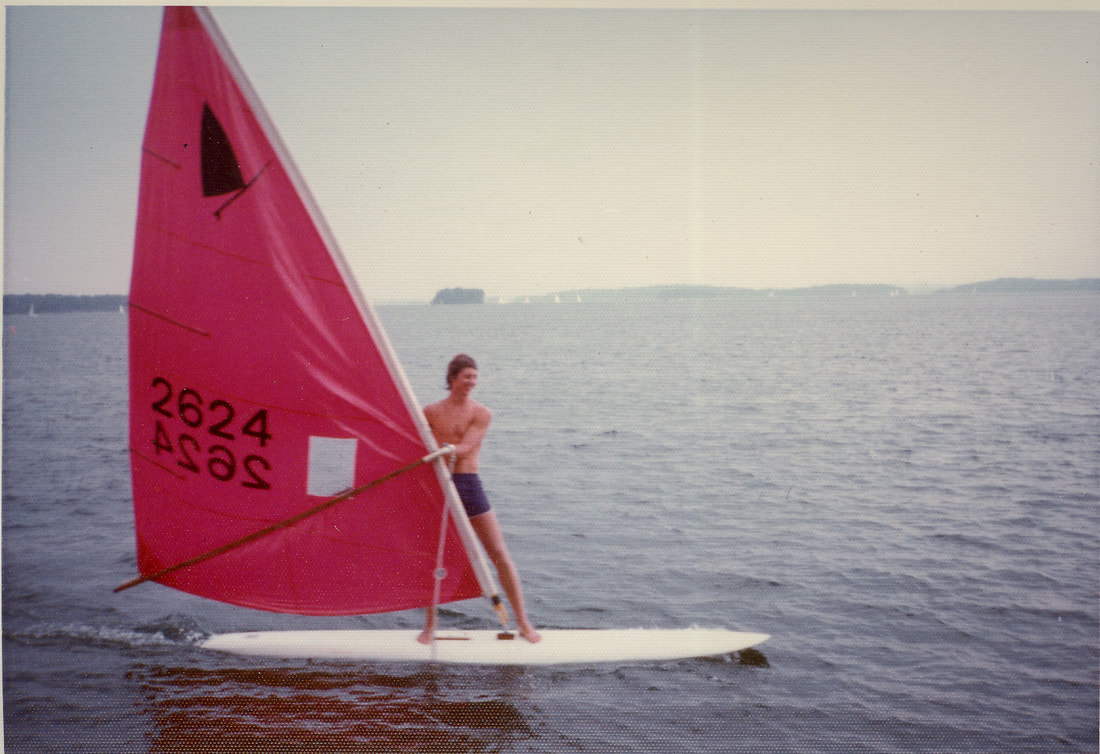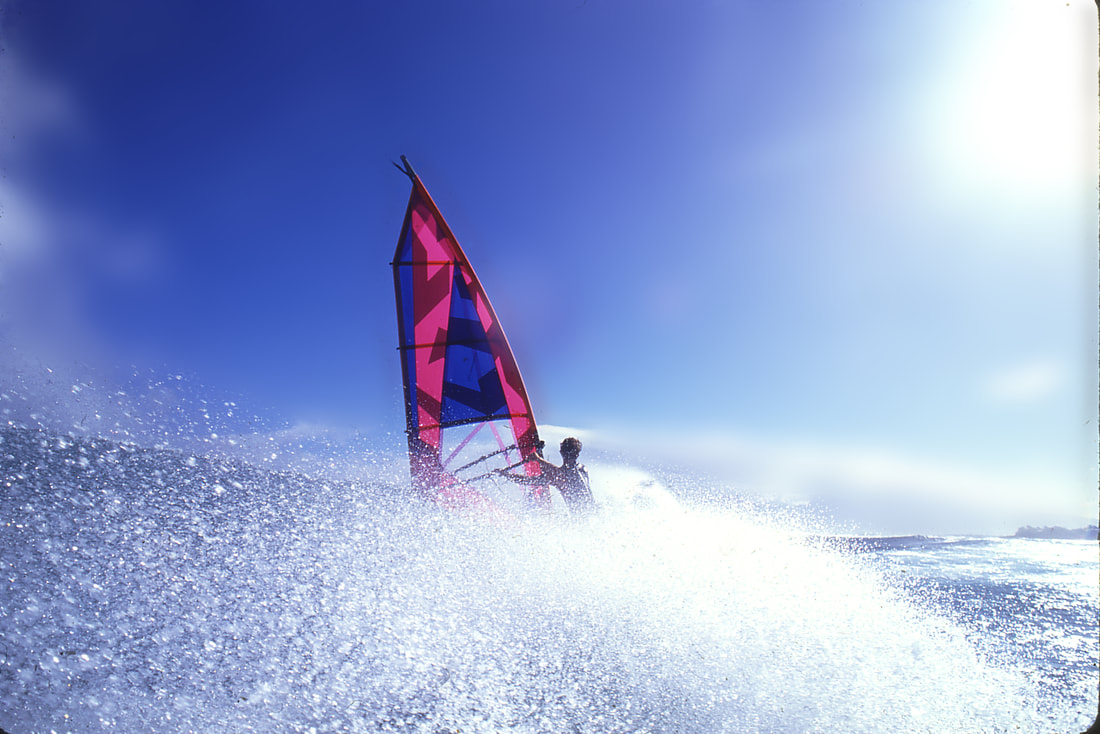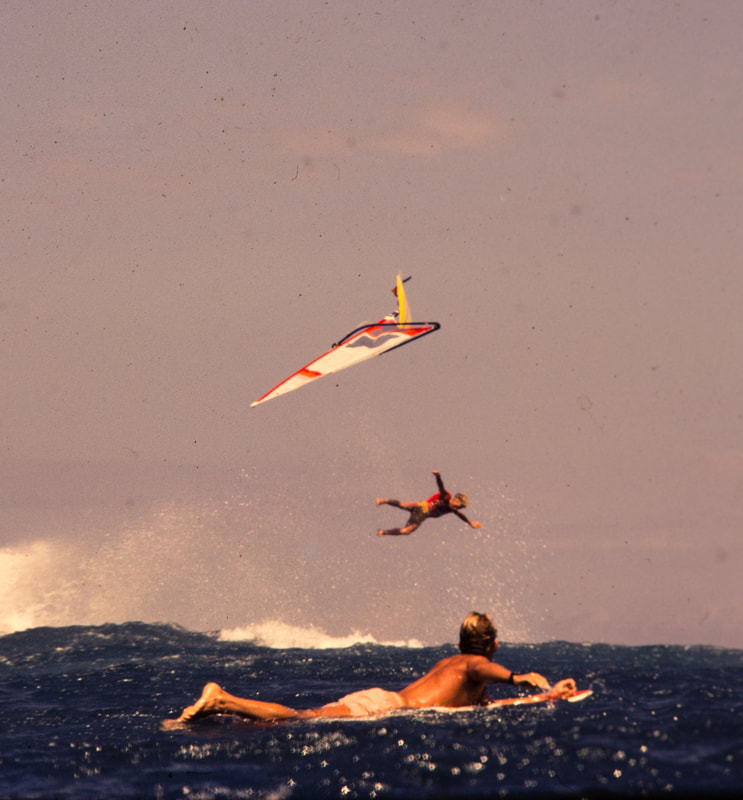 The following is Google Translate's best stab at translating the article from German. Jonathan Weston was one of the first water photographers to break into the Hookipa, made legendary surf films, plunged into the sea with a helicopter and had deep insights into the vibrant scene in Hawaii. An interview about golden times and what's left of it. Every windsurfer who lived the sport in the 80s and 90s knows his pictures and films. His job was to show the world through pictures how great is windsurfing. So this interview comes at least 30 years late. But better late than never, right? The windsurfing hype of the 80s has you washed from California to Hawaii, where you were one of the first water photographers and became a filmmaker and from there apparently also back to one Lake in Sacramento. A long story so where do you start? Best at the front. I had in the 70s studying photography School in Santa Barbara / California (Brooks Institute of Photography) started but when I was on some races raced quite successfully and always windsurfing took up more of my life I gave up my studies. Like everyone back then, I also dreamed of Hawaii.In 1980 I packed my home-made custom windsurfer, one of the first ever made with Gary Efferding from a block of foam dock and took it to Oahu. The beginnings there were wild. Ibought a car for $200 - no, it was more of a traveling wreck - that took me to the beach and me at the beginning partly as a place to sleep served. You quickly learned people, then lived in their garden and slept on the terrace. No money in my pocket. If some small change in the car under the seat found it was a great pleasure. Everything what mattered was windsurfing every day to go, nothing else. Sometime I needed some raw materials to shape a new board for me and ended up at Town & Country Surfboards factory in Pearl City / Oahu. At that time there were also manufacturers of surfboards an increasing Demand for windsurf boards, because Windsurfing was the fastest growing sport in the world. The owner the workshop, Craig Sugihara, said: "Bring your board over when it's done. If it looks good, we have to talk.” A shorter board later I had a job there as a shaper. In the early 80s, they were all Windsurfing pioneers first on Oahu landed. Why? At that time the material development was not very far yet advanced. Oahu was ideal, and it was the time when Robby Naish, who grew up on Oahu dominated. Maui, however, was unknown: and also completely at that time underdeveloped, the island was totally economically suspended - nobody wanted to do it voluntarily there. One day I was standing with mine Boss Craig in the workshop and showed him my latest board creation, a very short board (for a time when waterstarts were rare) with a wide tail and bat wings. 'Looks like the car from Batman’s, my boss said. A guy from Maui came along and if you continue building such boards I might give him your job. ’ The "guy" was Malte Simmer (later Founder of the Simmer sailing brand Style, the Red.) And he built even wilder Stuff than me - Batman's car on steroids so to say. Did he get your job? Fortunately not. But he showed me the first time pictures of Maui and wound up working for Barry Spanier at Maui Sails. That seemed like it worked out well for him. And he got to stay on Maui. Robby Naish was already the hero in 1981 of the sport. Do you remember how did you meet him for the first time? I still remember it well. (I’m sure he doesn’t!) He was already a superstar at the time. When he's at Diamond Head he usually started the garden of his girlfriend at the time, whose parents had a house there. Rarely he mingled with us mortals on the beach. He always had an entourage around him, they rigged his stuff sometimes. When everything was ready, surfed, he got out, flew through the air, took a wave and ripped it to pieces. I wondered for a long time if he can water start at all because he never crashed and still used his uphill. The windsurfing world existed then from Robby Naish, and things were moving fast. People like Mickey Eskimo or Pete Cabrinha even, lived in Robby's shadow even though they were world-class surfers. How did you get the hang of the life artist and shapers for photography to get? (How did I get from shaper to photographer?) I developed a friendship with a guy down on his luck, who packed the boards in the factory, his name was Warren Bolster. He was a pretty crashed hard fallen surf and photog I heard who hardly liked windsurfing, always with his provocative questions towards my shape creations. I got an old skateboarder magazine in the Fingers, and spotted on many of the Images copyright "Bolster". It turned out that Warren was legend because he had been a photographer and editor of the Skater magazine and documented the legendary Dogtown and Z-Boys. Unfortunately he was pretty crashed (alcoholic). So we become friends and I take him to the Diamond Head and he rushed with a water camera in the break. My boss had to pretty quickly find a new warehouse worker. And with me too that awakened the love of photography and I saw that here was a better opportunity for me, knowing the sport well as a participant, many years of photography school (Brooks Institute) yet to be put to use, and I was a strong swimmer But I was still too much into windsurfing up on the board to get down into the water. In what way? I had a new job or so they said at Surfer Publications with Sailboarder (I had pitched them the idea and was hired as editor then fired before it began because some guys said I was a fraud and didn’t know how to windsurf. ok), one of the big windsurf magazines of the day back then. I stood on the street in Dana Point, CA, leafed through the yellow Pages and finally applied to UP Sports. They built hangliders back then and sail and wanted also to offer windsurf boards. The condition at the time was: I get the job as a shaper if I did well at renowned Hang Ten Worlds at Cabrillo. So I did and beat Ian Boyd, lol, and Rhonda and Nancy, and a few others to do well. He was so young and women had to sail against men, but it counts. Steve Walden shaped my designs and off to Maui I went. How was it in those days? I came with Pete Cabrinha in 1981 there. It was tough even then, breaking ice in many ways. At my first day I ended up surfing session in Hookipa right on the rocks and destroyed my equipment. The spot was made by Wave surfers dominated and up to the point Defended blood. Five or more surfers at the break meant you stayed as Windsurfers do better on the beach (not true back then, we got along pretty good. It was Diamond Head I was referring to in the interview… whatever). And it gave windsurfers there like Mike Waltze the rash, who didn't like the spot becoming increasingly popular. But it could not be suppressed. How was it supposed in the times Milk and honey flowed and everyone could get good sponsors? During the early days – we are still talking about the early ones here 80s - it was by no means easy. There was Robby Naish, he was the king. And then the rest came. I personally couldn't complain, I had with Back then, UP Sports was a good sponsor. In 1982 I asked my boss about money to pay a hospital bill to be able to. I was over in Hookipa been driven to the pile and with her head on the bow of a surfer popped (interpretation… a girl bailed on a wave driving her board’s nose into my skull). My boss thought about it briefly and told me he was doing me a favor now would do: throw me out! He obviously thought I did would have been too easy so far and would have to bite through to discover my talents. So has he set me tough outside the door, although we're a really good one had a friendly relationship. Back then I was horrified, looking back of course he was right. This experience finally got me to take pictures and brought movies. Back then, film and photography was one completely different approach than today ... Absolutely. I ordered a water case. The first day I put it in Camera in, swam in Hookipa the line-up, looked through the viewfinder and saw my housing up was full (laughs). I had to work part-time for a long time as luau waiter and security guard to punch through until I get a new one Could afford housing, oh man. The first roll of film that I developed but it was already in itself. There were Photos by Mike Waltze, Fred Haywood and Matt Schweitzer, the likes of which had rarely been seen. My swimming abilities and sport knowledge put me in the pit. You are talking about some of the here greatest personalities of the sport. Was it your buddies back then? Or you just had to have the boys take pictures if you have the best Wanted pictures? The hard core of Maui surfers was back then still small, of course I knew everyone. Some were friends, others rather not. Mike Waltze was the one Top dog and even quite angry on me because of an article I times published in a magazine would have. It was about the fighting between windsurfers and surfers on Oahu. I ended the article with the words: "Move to Maui, I did!" According to Waltze, that had triggered a run on Maui. Like he had nothing to do with it. But we laugh about it now. Him owning all the parking spots and all. Revenge followed in your first photo session in the water? When I was in the line-up for the first time, Waltze came racing towards me. I was sure that he behead me (take my head off). Ironically, it is the picture that was created landed on the cover of my book, Maui Glory Days. What was so about your pictures at that time groundbreaking different? I was the first photographer to swim with the camera directly in the Impact Zone, at the point they call H Poko. Erik Aeder came a year later, but at the beginning I had this Spot for me alone, that was fantastic. There were lots of photogs on the hill with their big lenses, making all the money, but for me, this was a whole other sport, pretty much an impact sport. The real one breakthrough came with the first Helmet camera. The POV angle. We're probably not talking about here GoPro format ?! No not true. The thing was heavy as a bowling ball, I can hardly believe that I didn't break my neck (laughs). The first attempts we did in secret back then and are for the trial shots to Outer Sprecks (spot, a few kilometers southwest of Hookipa) drove where there was no one back then (my test talent, Miles Valle, Malte Simmer). There were 15 seconds of videotape recorded, but that cameras at that time couldn’t handle the shocks of the landings and it was just picture noise to see after that initial footage that basically changed my world and well, it would have happened without me, the GoPro evolution, but a patent might have been wise! All I cared about was sharing the vision. But after the shitty video, it was clear that I was going to have to shoot film. But film cannisters ran only for 30 to 45 seconds of usable material. Most of the time went for swapping cartridges, assemble everything, lick the lenses clean, around the annoying drops of water to bead off. But even this short snippets of film were enough to recognize what would be possible and doors open at sponsors. What is your specific tip? Good recordings are not made when you film yourself, but each other. Instead of filming yourself and water, it is better to pursue a great windsurfer. Terrifying is that a lot of people with super light GoPro tool modern action cams still don't understand how to take good cinema. That was my thing I guess. I was selfless in my imagery. That was the recipe for success back then of my first film, "Impact Zone". You also had a lot with Mickey back thenEskimo worked because of his Staging was always controversial. How did you find working with him? Mickey was just an amazing creative and he was sort of an outsider, and I liked the underdog with the underbite. His graphics adorned the Boards of different brands and he did everything to get a good shot to get. Whether he stood (landed) the move he didn't care or not, the main thing the photo became good. That brought him a lot of headwind in the scene, but ultimately he was creative with his Kind of extremely successful. Although he only won few heats, he had over 200 cover shots for windsurfing Magazines worldwide and sponsors like windsurfing Chiemsee. It was that Time when windsurfing became sexy and one at boot Düsseldorf Could fill halls with windsurf stuff. Mickey also threaded (helped me find sponsors for) years later a film project called Chiemsee "Double or Nothing" with Jason Prior and Francisco Goya. This movie had a script for the first time and should Drama and comedic elements - if you have the idiosyncratic sense shared for humor - combine and of course offer tangible action – for the case that the thing about acting and not so good at humor arrived. Everything went great - unfortunately I fell shortly before the shooting ended the helicopter. The image of the crashed helicopter in the Spreckelsville's line-up went around the World. What happened back then? I had filmed from the helicopter several times and knew it wasn't 100 Percent is safe. Therefore worked I like to be with a famous pilot together. He had messed up a lot in life and instead of going to prison he had to go as a service to the community Make reconnaissance flights, to dig illegal marijuana plantations. So he could do well in rough Flying off-road. On this day however, another pilot had to step in, that I didn't know. But it everything was arranged, so I didn't have any Choice. I hung on the side of the helicopter out with the camera in hand and filmed. The new was not lacking courage, but control. Once he almost cut off Robby Seeger's head. It was adventurous. I said: Let's break up! We flew via Sprecks towards the landing site and waited for the permission of the Towers, I discovered Jason Prior surf there. Jason actually should have been Long ago in Hookipa on the water supposed to be, he was one after all of my main protagonists - but how he was usually late and a little bit unplanned. I took the opportunity a few last shots of him too when I make a very strong gust saw coming closer. The gust pulled the Heli up, turned him over and it swung towards the side towards Water surface. I was still trying jumping out but forgot that I was was strapped on. When the rotors did that Water hit, it was the loudest Sound I have ever heard. Everything was silent for three seconds Pilot and I took a quick look at each other and a few moments later we were under water. The helicopter was on the Reef. I could see the surface above me see, but got one of the two seat belts are not on. I was under water for a long time, I guess like two minutes. Fortunately I had back then a horse lung. When I was liberated, I managed to show up briefly, but the camera with that heavy battery pack pulled me down again. Let go of the camera somehow didn't come in at that time the sense. I solved it under water released batteries (I later swam out and found them) and finally couldPop up. That I do that with easy Survived injuries was a great luck. Still was on timely completion of the film unthinkable at the time. (It was released four months late, Double or Nothing… better late than never). You filmed all the icons of the scene Who is left in your head? Mark Angulo and Jason Polakow. (mostly Craig Maisonville) They were just unique in their time regarding their creativity on the Water. Everything looked easier with them as if they were floating. Robby Naish was equally impressive but he was always better at Wind from the left. Mark Angulo was probably the one with the most talent. For the Angulo brothers Mark and Josh the rest did not only have good sides ... Mark could have won anything but unfortunately the creative are not always the most professional (not my words. Mark was Mark and less concerned about the professional side of the sport than pushing the limits). Jason Polakow was different there, he was more professional and is never lopsided Got caught. His problem was that constant injuries. I think there is hardly a bone in that not a screw is stuck. Would be less injured, he would have Dominate windsurfing even more can. On the other hand, it would be his kind easy to surf without injuries was not possible. What were you then - creative or professional? I share fate to some extent of the creative. I loved taking pictures but actually I always wanted to rather be on the water windsurfing myself, underneath then of course the work and it suffers came other photographers like Erik Aeder or Darrell Wong, the big deals landed with big brands. Why did you get the island from which you you dreamed for so long, in the end turned his back again? At some point there were other things more important. For example, school for my daughter. I was concerned about this not being a good place for her. I left there in 2000 (for a NASA gig in Sausalito and then to Carmel). With it I have this chapter in my book ended for me. Do you get a lot of feedback from the Legends of the scene, presumably who’ve read all? Little. Most protagonists don't want to read it, they don't want to look back. But I get a lot Praise from people who are normal windsurfers are and who like to look back and soak up the stories. It shows the life that many people would have liked back then But unfortunately for most people Hawaii stayed a dream.
0 Comments
Leave a Reply. |
|
||||||



 RSS Feed
RSS Feed